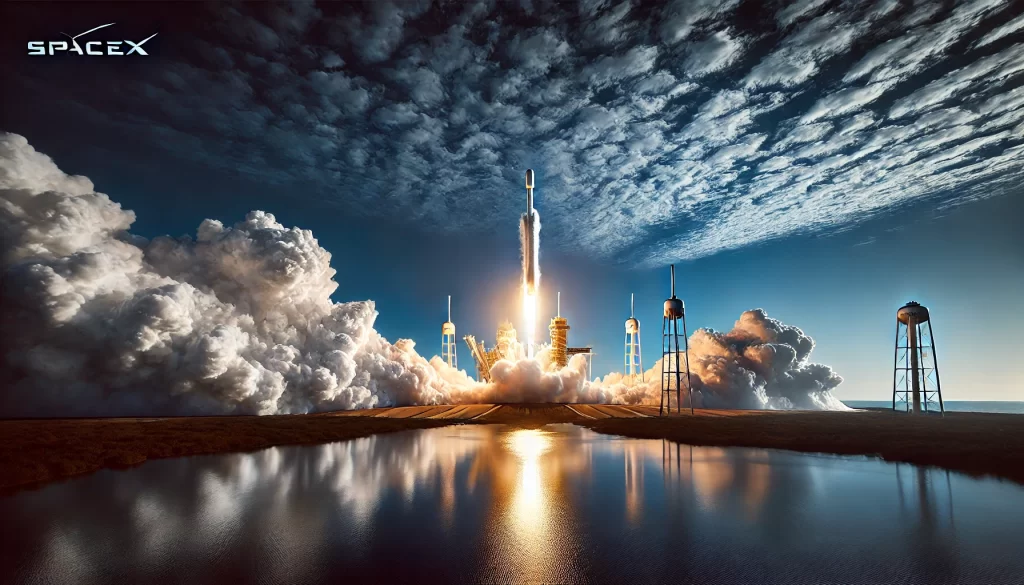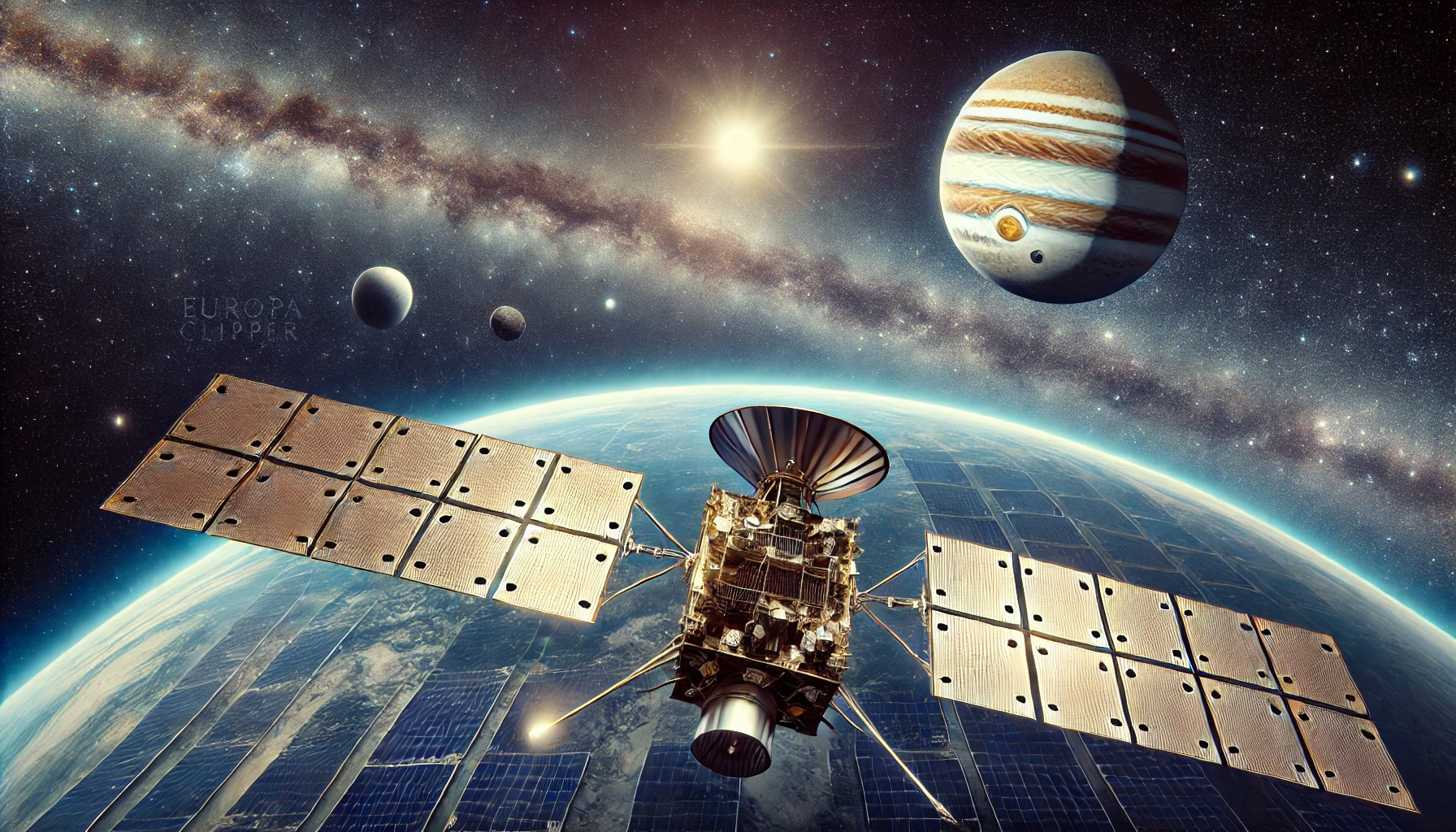NASA launched the Europa Clipper, its largest interplanetary spacecraft, on October 14, 2024, using a SpaceX Falcon Heavy rocket. The mission’s goal is to explore Jupiter’s moon Europa, a frozen world that scientists believe may contain the right conditions for life. The spacecraft lifted off from Kennedy Space Center in Florida after being delayed by Hurricane Milton. Now, it embarks on a 1.8 billion-mile journey expected to take around six years.
Europa is about the same size as Earth’s moon, but it’s special because scientists think there is a deep ocean under its icy surface. This ocean could be more than twice the volume of all Earth’s oceans combined. The Clipper mission aims to study this ocean and see if it has the essential ingredients for life. While it won’t search for living organisms, it will look for clues that show if Europa could support life, such as water, chemical energy, and organic compounds.
The spacecraft carries nine scientific instruments, including a radar system that can penetrate the ice to study the ocean beneath, cameras for taking detailed pictures, and devices to measure Europa’s magnetic field. One of its instruments, an ultraviolet spectrometer, will help identify gases and molecules in Europa’s thin atmosphere. The spacecraft also has tools to measure how thick Europa’s ice shell is and to look for any warm spots that might indicate where the ice is thinner. Scientists believe that warm areas could be places where the ocean is closer to the surface, which could increase the chances for life.
Getting to Jupiter is no easy task. Europa Clipper will use the gravity of Mars and Earth to gain speed, a technique called a gravity assist. The spacecraft will first pass by Mars in February 2025 and then return close to Earth in December 2026. By the time it reaches Jupiter in April 2030, the spacecraft will be moving fast enough to start orbiting the giant planet. Once there, it will make 49 close flybys of Europa over four years, flying as close as 16 miles above the moon’s surface. This will allow the Clipper to gather detailed data that will help scientists understand Europa’s icy crust and the ocean below.

The Europa Clipper has faced challenges in its development. Budget issues almost canceled the mission several times, and it took years of advocacy by groups like the Planetary Society to secure funding. The spacecraft was originally planned to fly on NASA’s more expensive Space Launch System rocket, but in 2021, Congress allowed NASA to choose SpaceX’s Falcon Heavy rocket, saving millions of dollars.
There are still many unknowns about Europa. Scientists think that tidal forces from Jupiter’s gravity stretch and compress the moon, creating enough heat to keep water beneath the ice in a liquid state. The Clipper will search for signs of this process by studying the moon’s magnetic field and looking for any changes that might indicate liquid water moving under the surface. Scientists are also interested in “cryovolcanoes,” which could be erupting plumes of water or other materials from beneath the ice. If Europa Clipper flies through one of these plumes, it could directly sample material from the ocean, offering even more clues about what lies below.
In addition to its scientific instruments, the Europa Clipper is equipped to withstand the harsh conditions near Jupiter, including intense radiation. The spacecraft’s sensitive electronics are protected by a thick shield made of aluminum and titanium. During its flybys, the spacecraft will spend less than a day in Europa’s radiation zone before retreating to a safer orbit, repeating this pattern every two to three weeks.
Scientists hope that the data from Europa Clipper will answer key questions about Europa’s habitability. The mission is part of a broader effort to explore “ocean worlds” in the outer solar system, where liquid water is hidden beneath layers of ice. While it may take years to analyze all the data, scientists believe that this mission could be a major step toward understanding if life might exist elsewhere in our solar system.
This article is based on the following articles:
https://www.usatoday.com/story/news/nation/2024/10/14/europa-clipper-launch-jupiter-moon/75583715007
https://www.washingtonpost.com/business/2024/10/13/spacex-starship-rocket-booster-launch
https://www.npr.org/2024/10/13/nx-s1-5151863/europa-clipper-jupiter-launch-moon

Background Information
1. NASA and Space Exploration
- NASA (the National Aeronautics and Space Administration) is the United States government agency responsible for space exploration. Since its creation in 1958, NASA has sent astronauts to the moon, built the International Space Station, and launched numerous robotic missions to explore other planets.
- Space exploration often involves sending robotic spacecraft to other planets, moons, and celestial objects. These missions help scientists gather data that would be impossible to collect from Earth.
- Robotic missions can take years to reach their destinations because of the vast distances involved. For example, the Europa Clipper will take about six years to reach Jupiter.
2. Understanding Jupiter
- Jupiter is the largest planet in our solar system, about 11 times wider than Earth. It is a gas giant, meaning it’s mostly made of gases like hydrogen and helium, rather than solid materials.
- Jupiter has a very strong gravitational pull because of its size. It also has a powerful magnetic field, which can create high levels of radiation that can damage spacecraft.
- This planet is surrounded by a family of moons—95 in total—that vary in size and characteristics. Some of these moons, like Europa, have sparked interest because they might have conditions that could support life.
3. Europa: Jupiter’s Mysterious Moon
- Europa is one of Jupiter’s four largest moons, along with Io, Ganymede, and Callisto. These moons were discovered in 1610 by astronomer Galileo Galilei.
- Europa is a bit smaller than Earth’s moon, but it’s very different. Its surface is covered with a thick layer of ice, and scientists believe there is a vast ocean of salty water beneath this icy crust.
- The idea of an ocean on Europa is exciting because water is essential for life as we know it. Even though Europa’s surface temperatures are extremely cold, the moon could have liquid water because of a process called “tidal heating,” which occurs when Jupiter’s gravity stretches and compresses Europa, creating heat.
4. Why Europa Could Be Special for Finding Life
- Life as we know it requires three things: water, energy, and the right chemicals. Europa has water and may have sources of energy from tidal heating, and scientists want to find out if it has the necessary chemicals.
- While Earth is the only place in the solar system known to support life, scientists think that Europa and other “ocean worlds” might also have the right conditions.
- However, finding life or even signs that a place could support life is very difficult. The Europa Clipper mission will help scientists learn more about Europa’s environment to see if it has what it takes to support life.
5. How Spacecraft Like Europa Clipper Work
- Spacecraft that travel far from Earth are powered by solar panels, which convert sunlight into electricity. However, since Jupiter is much farther from the Sun, spacecraft need very large solar panels to generate enough power.
- Instruments on spacecraft can include cameras, radar, and spectrometers. These tools help scientists study the surface, atmosphere, and magnetic fields of distant planets and moons.
- Missions like Europa Clipper use “gravity assists” to increase their speed without using extra fuel. By flying close to planets like Mars and Earth, the spacecraft can gain a boost from the planets’ gravitational pull, helping it reach distant destinations like Jupiter.
6. The Challenges of Space Missions
- Space missions can be very expensive and take a long time to plan and launch. The Europa Clipper mission has been in development for over 20 years, and it cost more than $5 billion to build and launch.
- Spacecraft must be built to handle extreme conditions, like the freezing temperatures and high radiation levels around Jupiter. Special materials and designs protect the equipment and allow the spacecraft to keep working in these harsh environments.
7. Scientific Instruments on the Europa Clipper
- Instruments on the Europa Clipper will measure things like the thickness of Europa’s ice, the composition of its surface, and the strength of its magnetic field.
- These tools can help scientists look for things like organic molecules, which are the building blocks of life, and signs of geological activity, like cryovolcanoes, which could bring materials from Europa’s ocean to the surface.
8. The Importance of Missions Like Europa Clipper
- Studying moons like Europa can teach scientists about more than just our solar system. Many other planets and moons in the galaxy could have similar icy oceans. Learning about Europa helps scientists imagine what kinds of environments might support life beyond Earth.
- Even if scientists don’t find life on Europa, the mission will still provide valuable information about the moon’s geology, atmosphere, and possible ocean. This knowledge could guide future missions, perhaps one day even sending a lander to explore the surface or drill through the ice.

Debate/Essay Questions
- Would finding signs of life on Europa change our perspective on humanity’s place in the universe? Why or why not?
Please subscribe to Insight Fortnight, our biweekly newsletter!
